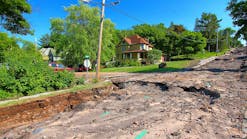New space observations reveal that, since October 2003, the aquifers for California's primary agricultural region--the Central Valley--and its major mountain water source--the Sierra Nevadas--have lost nearly enough water combined to fill Lake Mead, America's largest reservoir. The findings, based on data from the NASA/German Aerospace Center Gravity Recovery and Climate Experiment (Grace), reflect California's extended drought and increased rates of groundwater being pumped for human uses such as irrigation.
In research being presented at the American Geophysical Union meeting in San Francisco, scientists from NASA and the University of California, Irvine, detailed California's groundwater changes and outlined Grace-based research on other global aquifers. The twin Grace satellites monitor tiny month-to-month changes in Earth's gravity field primarily caused by the movement of water in Earth's land, ocean, ice and atmosphere reservoirs. Grace's ability to directly “weigh” changes in water content provides new insights into how Earth's water cycle may be changing.
Combined, California's Sacramento and San Joaquin drainage basins have shed more than 30 cu km of water since late 2003, said professor Jay Famiglietti of the University of California, Irvine. A cubic kilometer is about 264.2 billion gal, enough to fill 400,000 Olympic-size pools. The bulk of the loss occurred in California's agricultural Central Valley. The Central Valley receives its irrigation from a combination of groundwater pumped from wells and surface water diverted from elsewhere.
"Grace data reveal groundwater in these basins is being pumped for irrigation at rates that are not sustainable if current trends continue," Famiglietti said. "This is leading to declining water tables, water shortages, decreasing crop sizes and continued land subsidence. The findings have major implications for the U.S. economy, as California's Central Valley is home to one-sixth of all U.S. irrigated land, and the state leads the nation in agricultural production and exports."
Preliminary studies show most of the water loss is coming from the more southerly located San Joaquin basin, which gets less precipitation than the Sacramento River basin farther north. Initial results suggest the Sacramento River basin is losing about 2 cu km of water a year. Surface water losses account for half of this, while groundwater losses in the northern Central Valley add another 0.6 cu km annually. The San Joaquin Basin is losing 3.5 cu km a year. Of this, more than 75% is the result of groundwater pumping in the southern Central Valley, primarily to irrigate crops.
Famiglietti said recent California legislation decreasing the allocation of surface waters to the San Joaquin Basin is likely to further increase the region's reliance on groundwater for irrigation.
"This suggests the decreasing groundwater storage trends seen by Grace will continue for the foreseeable future," he said.
Source: NASA






